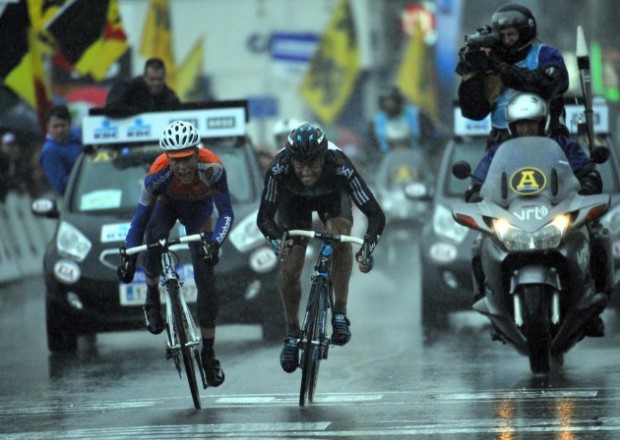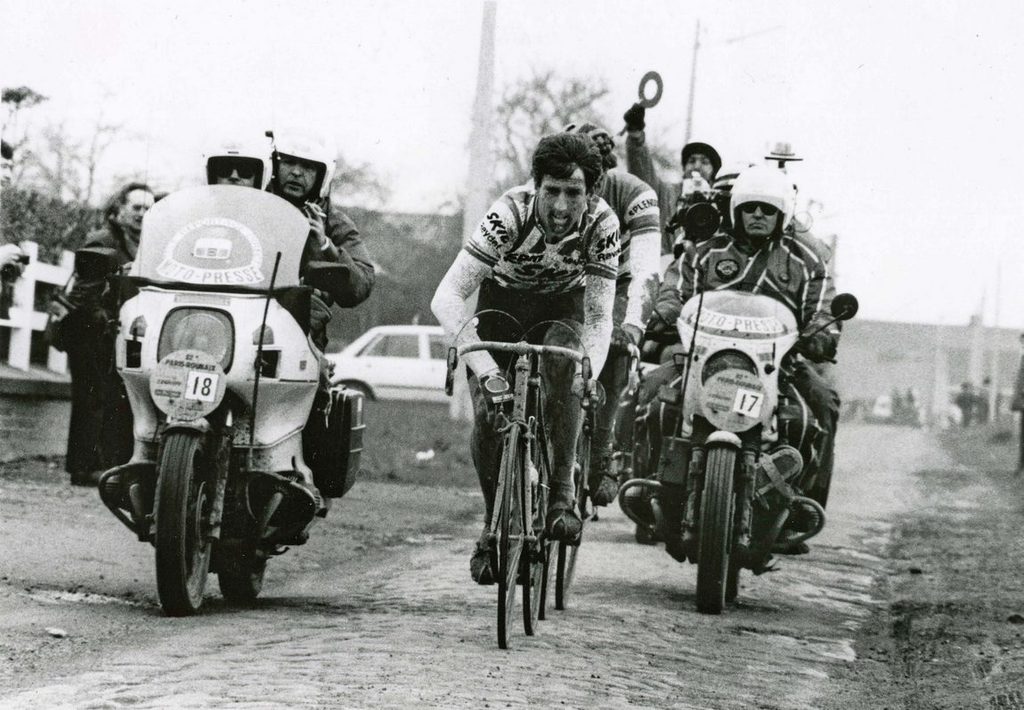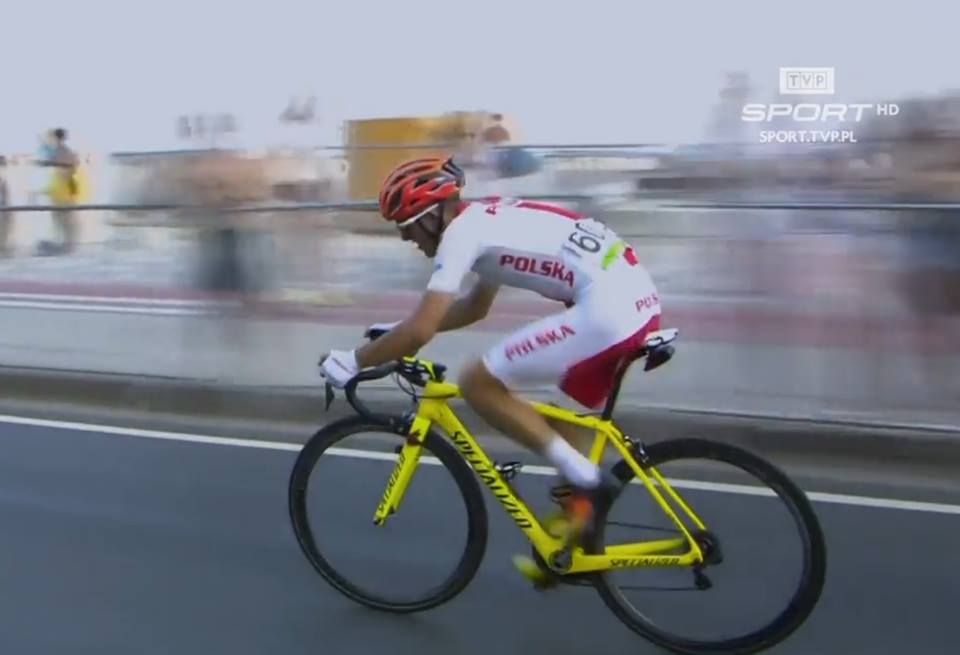Let the Season Begin

Omloop het Nieuwsblad is fast approaching on March 1st, Strade Bianche goes off the next weekend; finally, ladies and gentlemen, we have a season. For me the racing season really has to start in cold, wet Europe. I like the Tour Down Under just fine, I watch it, but it’s too early, too sunny and too hot to signify the start of the racing season. The races in the desert, though I’m sure they are windy and tough, hold no interest for me. Camels and embrocation do not compute. The endless speculation about Faboo’s lack of perfect February form only means every reporter is bored and has no real stories to write.
The most interesting thing about the racing in the Middle East was seeing that Tom Boonen is whippet thin and ready to bring the pain in 2014. Knowing that Boonen is back lets me sleep better at night. He is lining up for Omloop, his team is ready to rumble on the Taaienberg, all is right with the cycling world. Please let it rain, but don’t let Tommeke get hurt.
I need to see some racers with every bit of wet weather gear on, riding into a hell storm off the North Sea. Cold and wet and in Belgium; that is the way we start the season.
The other thing that is great with the cycling world is the Strade Bianche the following week. A gravel race for the professionals? The race is new, not even ten editions have been raced, but it seems so right. San Gimignano to Siena, rolling up and down across the Tuscan countryside, many secteurs of white gravel, this is a stroke of Italian genius.
Another reason to be excited is Peter Sagan. The wheelie poppin’ curb jumpin’ bad boy comes into this season a year wiser. He has watched both Fabs and Tommeke ride away from him in different editions of the Ronde but they aren’t getting any younger and Sagan is only getting better. The younger generation of riders would like to topple the reigning twin kings of the Spring Classics but Boonen and Cancellara are still there because they are the two best Spring Classic riders of their generation. They aren’t going to go without a battle.
If no one breaks bones in the feed zones or gets infected elbows, this all portends a beautiful spring.


Anyone have some pointers for climbing the cobbled hills in the classics? I did the Omloop het Nieuwsblad this weekend and while my legs are improving in their ability to handle 20% grades, I have difficulty keeping enough traction on the mud covered cobbles to keep going up hill.
Riding up the gutters helps tremendously, but they aren’t always available, make you feel like a pussy, and are routinely clogged by people who have come off or slowed to a crawl.
I’ve also dumped the PSI down to 80 or so as I’m only 70kg, but that seems a dangerous route given the length of these routes and number of cobbled sections… I’m also sure the 53/39 doesn’t help as your stroke isn’t as smooth as it would otherwise be if you were spinning a compact.
Is the answer wider tires? Does switching from 700x23c really make a huge difference?
Apologies if a stupid answer, just continuing my quest to conquer the classics! BTW for anyone who hasn’t done the course its absolutely amazing. Probably my 2nd favorite ride behind LBL in Belgium. Extremely well designed with lots of variation in scenery and terrain.
Wow, what a race Kuurne Brussels and back was – won’t spoil it for anyone, as whilst the pic above shows the finish, the bit from halfway on was legend – well worth watching from just before the Kwaremont on – lashings more V in a very different sort of way – OPQ clearly have the guns fully loaded for the classics
@Rob
just watching KBK made me yearn for blasting around the Belgian roads again – there is something special about them, almost as if they were designed for cycling rather than vehicles
I’ve just laced some HEC C2 tubular rims to take 25mm Veloflex Roubaix tubs, as our roads are so shite here that I may as well be on the cobbles, and I am conviced they will make a huge difference even though I haven’t finished building them! So there is a more stupid answer than your question…..over to the professional Vers for a sensible answer
….is it because the Belgian’s don’t seem to bother with hedges or walls or something, but you can tell you are watching a Belgian bike race as soon as you swith the telly on
I see there’s been a bit of a fuss (storm level: in a teacup) from Lotto riders regarding OPQS and Belkin making the break up a tarmac bike path rather than a cobbled road, with respect to the new UCI rule that says “stick to the road”.
@Rob
Go to 25mm and be prepared to never return to 23mm. Races are won and lost over very small differences — even if you are just riding on V for yourself.
@Rob I’m no expert, but losing traction uphill can only mean too much weight on the front, or a loose surface.
If standing I try to have my hands to the side of the bars and just rock them back and forth, not on top of the hoods and leaning on them. This is hard when you are tired. But it also means all the weight is going straight down through the cranks and therefore bottom bracket, meaning, as the bike is on an incline and the angles of weight work to put the weight more through the back wheel.
If sitting, again rather than leaning on the bars, or indeed pulling up on them (wheelie city on a 20%!) you pull horizontally backwards (horizontally with reference to the bike, not the hill) towards the back of the bike, which pushes the weight again more to the rear wheel.
But other than that, you must pedal as smooth as you can in a circle. Typically I lose traction on the downstroke, and then know I must work harder on the under and back-upwards sections of the stroke. When you go full circle and not choppy, the bike climbs smoothly and you don’t give it a chance to skip. If it does skip, then your smooth motion helps regain traction, plus you have better form on the bike so will be more balanced to recover better.
And then sometimes if you hit gravel, mud or slime, there will be little you can do other than try and keep pedalling for the centrifuge/balancing effect until you get traction again. Often you’ll still fall off.
I one day want to ride the cobbles, but I would say the width of tyre is not increased for the climbs, it is for comfort and puncture resistance with a bigger bag between rim and cobble. The increased bounce a 23mm gives on a cobbled climb may hurt, but then you have higher kg per sq mm pressure to grab traction, which I would have thought would help with traction on a hill.
That’my thoughts anyway, MTB and greasy road experience.
Super jealous of your cobble ride!
I recently switched to 25mm from 23mm, it is noticeably more comfortable on rougher surfaces. I didn’t notice any more speed, but I am not PRO.
@Rob
And… Aannndd… stayed on 25mm all of 2013 and never flatted. Ehh? Eehhhh??
About to mount GP 4000s II (25mm) tyres to attempt another year without flatting.
@Rob 25+ mm tubulars, lower pressure, more souplesse in your pedal stroke.
@all thanks for all the advice. I’ve never had a problem really with flats once I learned to actually steer around potholes or bunny hop over, but think I’ll pick up a set of vittoria pave to see the difference. Everyone says bigger is less rolling resistance anyways….
I know the smoothness of my stroke surely isn’t great with the 53/39 putting me at a cadence of 40-50 on the steep sections but it is what it is. All you can do is barely touch the handlebars, lean back, and be thankful you spent time on the rollers and have good balance to hang on as you start slipping and sliding. Think the only other real difference between myself and the others is it seems like alot of the guys really try to carry as much speed as possible into the hill. I normally maintain my flat speed of 27-28 and just try to carry that as smoothly up the hill. I think the quickest ones are maybe even sprinting beforehand so that they don’t have to apply as much power on the hill itself?
@Beers There was some good advice in there, but I couldn’t help but wonder how much time you’ve spent on Belgian cobbles :) Yesterday wasn’t that bad, but you know these nutters have 30% cobbled climbs? With holes between cobbles like on the sections to Roubaix…….like you have to walk your bike down hill unless you enjoy face planting on pavé. Yesterday was good fun as I’ve learned to let go of my American ego and just do the best I can, plenty of flandrians walking those climbs so you are in good company if you can keep smiling.
@Rob
Absolutely yes on the notion of more mo’ at the bottom of a cobbled climb, then try to keep that momentum going by spinning up the climb. Also, I believe the 25mm tire, run at 5.5 bar would improve traction too, more rubber gripping the stones. Lastly, and I only know this from our local <20% paved climb, there is a sweet spot on the nose of the saddle where there is just enough weight on the front wheel to keep steerage and enough weight on the rear to keep traction. And this only works sitting down, sliding forward on the saddle. Getting up a steep cobbled climb? Very subtle skills the locals have practiced for many years might be their secret. I have no experience doing it, I believe I would be pushing the bike. Keep at it!
@Mike_P What a photo !! Wow !! And that may rep well and proper racing and certainly I cannot help but be much impressed but I have to admit, that that is racing I’d prefer to watch than participate. I contrast the start of the season in Belgium with the start of the season in Alabama. Our little local muni park mtn bike race to kick off the state series was in blue skies and sunshine and perfect temps and perfect trails = little mud and little sweat. Might not have made for impressive pictures of hard men but sure was a blast. RC
Excuse me……
Strade Bianche has such an awesome finishing stretch, and the whole top ten came in one at a time. Great jump on the steepest section for the win.